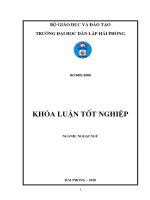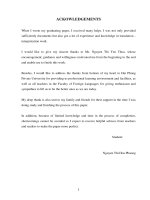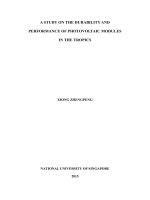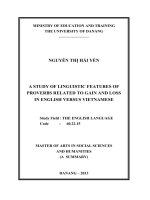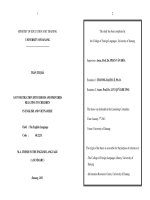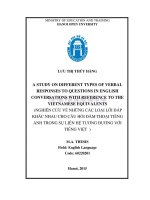A study on English idioms and proverbs relating to colors in comparision with Vietnamese
Bạn đang xem bản rút gọn của tài liệu. Xem và tải ngay bản đầy đủ của tài liệu tại đây (1.1 MB, 59 trang )
BỘ GIÁO DỤC VÀ ĐÀO TẠO
TRƯỜNG ĐẠI HỌC DÂN LẬP HẢI PHÒNG
-------------------------------
ISO 9001 : 2008
KHÓA LUẬN TỐT NGHIỆP
NGÀNH: NGOẠI NGỮ
HẢI PHÒNG – 2012
1
HAIPHONG PRIVATE UNIVESITY
FOREIGN LANGUAGES DEPARTMENT
-----------------------------------
GRADUATION PAPER
A STUDY ON ENGLISH IDIOMS AND PROVERBS RELATING
TO COLORS IN COMPARISION WITH VIETNAMESE
By:
Nguyen Thi Huyen Trang
Class:
NA1202
Supervisor:
Mrs. Nguyen Thi Yen Thoa, M.A
2
BỘ GIÁO DỤC VÀ ĐÀO TẠO
TRƯỜNG ĐẠI HỌC DÂN LẬP HẢI PHÒNG
--------------------------------------
Nhiệm vụ đề tài tốt nghiệp
Sinh viên: ..............................Mã số:.....................................................
Lớp: ............................ …….Ngành:......................................................
Tên đề tài: ...........................................................................................
...................................................................................................
.....................................................................................
3
Nhiệm vụ đề tài
1. Nội dung và các yêu cầu cần giải quyết trong nhiệm vụ đề tài tốt nghiệp
( về lý luận, thực tiễn, các số liệu cần tính toán và các bản vẽ).
……………………………………………………………………………..
……………………………………………………………………………..
……………………………………………………………………………..
……………………………………………………………………………..
……………………………………………………………………………..
……………………………………………………………………………..
……………………………………………………………………………..
……………………………………………………………………………..
2. Các số liệu cần thiết để thiết kế, tính toán.
………………………………………………………………………………..
………………………………………………………………………………..
………………………………………………………………………………..
……………..……………………………………..…………………………..
………………..……………………………………………………………..
…………….…………………………………………………………………..
4
………………….……………………………………………………………..
………………………………………………………………………………..
………………..……………………………………………………………..
3. Địa điểm thực tập.
………….……………………………………………………………………..
………………………………………………………………………………..
……..………………………………………………………..………………..
……………………………………………………………..………………………
………………………………………………………..……………………………
…………………………………………………..…………………
5
CÁN BỘ HƯỚNG DẪN ĐỀ TÀI
Người hướng dẫn thứ nhất:
Họ và tên:.............................................................................................
Học hàm, học vị:...................................................................................
Cơ quan công tác:.................................................................................
Nội dung hướng dẫn:............................................................................
Người hướng dẫn thứ hai:
Họ và tên:.............................................................................................
Học hàm, học vị:...................................................................................
Cơ quan công tác:.................................................................................
Nội dung hướng dẫn:............................................................................
Đề tài tốt nghiệp được giao ngày…….. tháng …… năm 20……
Yêu cầu phải hoàn thành xong trước ngày…… tháng …… năm 20….
Đã nhận nhiệm vụ ĐTTN
Đã giao nhiệm vụ ĐTTN
Người hướng dẫn
Sinh viên
Hải Phòng, ngày…. Tháng….. năm 20….
HIỆU TRƯỞNG
6
GS.TS.NGƯT Trần
Hữu Nghị
PHẦN NHẬN XÉT TÓM TẮT CỦA CÁN BỘ HƯỚNG DẪN
1. Tinh thần thái độ của sinh viên trong quá trình làm đề tài tốt nghiệp:
……………………………………………………………………………..
……………………………………………………………………………..
……………………………………………………………………………..
……………………………………………………………………………..
……………………………………………………………………………..
……………………………………………………………………………..
2. Đánh giá chất lượng của khóa luận (so với nội dung yêu cầu đã đề ra trong
nhiệm vụ Đ.T. T.N trên các mặt lý luận, thực tiễn, tính toán giá trị sử dụng,
chất lượng các bản vẽ)
……………………………………………………………………………..
……………………………………………………………………………..
……………………………………………………………………………..
……………………………………………………………………………..
……………………………………………………………………………..
Cho điểm của cán bộ hướng dẫn :
(ghi bằng cả số và chữ)
Hải Phòng, ngày ….. tháng ..… năm 20…
Cán bộ hướng dẫn
(họ tên và chữ ký)
7
NHẬN XÉT ĐÁNH GIÁ
CỦA NGƯỜI CHẤM PHẢN BIỆN ĐỀ TÀI TỐT NGHIỆP
1. Đánh giá chất lượng đề tài tốt nghiệp về các mặt thu thập và phân tích tài liệu,
số liệu ban đầu, giá trị lí luận và thực tiễn của đề tài.
2. Cho điểm của người chấm phản biện :
(Điểm ghi bằng số và chữ)
8
Ngày.......... tháng......... năm 20…
Người chấm phản biện
Acknowledgements
During the process of my implementing research paper, I have been lucky
to receive a lot of assistance, guidance and encouragement from many people.
First of all, I would like to express my thanks to my supervisor, Mrs
Nguyen Thi Yen Thoa, M.A; for her suggestions, guidance, and all the valuable
materials she has supported me. I also whole-heartedly thank all of the teachers
in foreign language department of Haiphong Private University, providing
materials for this study and having taught me through four years of university.
Last but not least, I am really in debt to my family and all my friends for
what they have done for me with the encouraging, supporting and being variable
well spring of ideas for entries. The completion and success of my research
paper would not have been achieved without their help.
Haiphong, November 2012
Nguyen Thi Huyen Trang
9
Table of content
Acknowledgment
PART 1: INTRODUCTION .......................................................................... 1
1. Rationale ....................................................................................................... 1
2. Scope of the study ........................................................................................ 2
3. Aims of the study ......................................................................................... 2
4. Methods of the study .................................................................................... 3
5. Design of the study ....................................................................................... 3
PART 2: DEVELOPMENT .......................................................................... 4
CHAPTER 1: THEORETICAL BACKGROUND .................................... 4
1. Language and Culture ............................................................................... 4
1.1. What is language? ..................................................................................... 4
1.2. What is culture ?......................................................................................... 6
1.3. Language and Culture ............................................................................... 9
2. An overview of idioms ................................................................................ 10
2.1. What is an idiom? ...................................................................................... 10
2.2. Some common features of idioms ............................................................. 13
3. An overview of proverbs ............................................................................ 14
3.1. What is a proverb? .................................................................................... 14
10
3.2. Some common features of proverbs .......................................................... 15
4. The distinction between idioms and proverbs ......................................... 16
5. The groups of idioms and proverbs .......................................................... 16
CHAPTER II: ENGLISH IDIOMS AND PROVERBS RELATING TO SIX
MAIN COLOR: BLACK, WHITE, RED, BLUE, GREEN, PINK .......... 18
1. English idioms and proverbs relating to black......................................... 18
1.1. “Black sheep” ................................................................................. 18
1.2. “Black mail” ................................................................................... 20
1.3. “In the black” .................................................................................. 221
2. English idioms and proverbs relating to white ........................................ 23
2.1. “White lie” ...................................................................................... 23
2.2. “As white as a ghost” ...................................................................... 24
3. English idioms and proverbs relating to green ....................................... 26
3.1. “Green light” ................................................................................... 26
3.2. “Grass is always greener on the other side” ................................... 28
4. English Idioms and proverbs relating to blue ......................................... 29
4.1. “Feeling blue” ................................................................................. 30
4.2. “Once in a blue moon” .................................................................... 31
5. English idioms and proverbs relating to red ........................................... 33
5.1. “Red letter day” .............................................................................. 33
5.2. “Red neck” ...................................................................................... 34
6. English idioms and proverbs relating to pink ......................................... 36
6.1. “Tickled pink” ................................................................................. 36
6.2. “To see pink elephant” .................................................................... 37
11
CHAPTER III: RELATED PROBLEMS FACED BY ENGLISH
LEARNERS AND SUGGESTED SOLUTIONS ........................................ 40
1. Some difficulties in studying idioms and proverbs ..................................... 40
2. Suggested solutions ...................................................................................... 41
PART 3: CONCLUSION .............................................................................. 43
REFERENCES ............................................................................................... 44
12
PART 1: INTRODUCTION
1. Rationale
Nowadays, English is the most widely used in the world and plays an important
role in the development of the society. English is not only the effective means of
communication but also shows its progressive effects in many aspects of life.
Idioms and proverbs are one of the most important parts of English. It was used
in all kinds formal and informal, spoken and written to “make our observation
and explanations more lively and interesting” (Horby, Idiom dictionary ). A
good understanding of how idioms and proverbs are used in everyday language
is important for students of English not only to increase vocabulary, but also to
understand the language deeply when we hear or speak about them. In spoken
English, they are used in most situations, from friendly conversations to business
meetings. In written English, they are especially common in newspapers because
the writers want to make the headlines and articles interesting and lively.
This interesting topic has attracted a large number of scientific researchers as
well as numerous students. Even little children are interested in learning idioms,
as they teach them a lot about life and the way some people behave. I learned so
many interesting and useful things from this topic: understanding profound
aspects of culture of both English and Vietnamese nations. Most native English
speech is idiomatic. Furthermore, learning and using idioms helps us to
remember well what we have learned. The wise men like using idioms so that
their daily communication and speech become more natural, interesting and
effective. For such these reasons I decided to choose idioms and proverbs for my
study. There are many sources of English idioms including: animals, fruits,
13
money, numbers and so on; however, I only take English color idioms and
proverbs into consideration. Thus, I would like to study about it in my paper. I
hope with this study, readers can know them well and apply in communication
successfully.
2. Scope of the study
Idioms and proverbs are so large and difficult aspect of each language so my
graduation paper cannot cover all color idioms and proverbs; it only focuses on
some main colors such as: black, white, red, blue, green, pink.
3. Aims of the study
Idioms and proverbs are an extremely difficult topic, which is hardly understood
by foreign learners of English, and even native speakers. Being aware of this fact,
I appreciate the idioms and proverbs associated to attitude and behavior of the
speakers. Sometimes we can ignore the spelling mistakes because we still
understand, but if someone uses the wrong idioms or proverbs, we cannot
understand. Therefore, my research is aimed at:
-
Collecting and classifying some idioms and proverbs which are usually
used in Vietnamese and English language.
-
Comparing and contrasting some similarities and differences between
these two cultures.
-
Giving some techniques to help learner use idioms and proverbs in a
correct way.
14
4. Methods of the study
In order to learn English and Vietnamese idioms and proverbs relating to some
main colors and to make learners recognize the important roles of idioms and
proverbs in life, the following methods are used in the studying process:
-
Material analysis: reading reference books to find and collect needed
information. On the other hand, collecting the specific examples for study.
-
Consultations: having discussion with the supervisor, experts and friends.
-
Comparison and contrast: selecting, comparing and contrasting examples
in English idioms and proverbs and Vietnamese ones in order to find the
similarities and differences.
5. Design of the study
This paper provides a clear organization consisting three main parts, which are
very easy to explore and learn. Part I- Introduction, consists of five small parts
namely Rationale, Scope of the study, Aims of the study, Methods of the study
and Design of the study. Part II – Development, consists of three chapters:
Chapter 1, Theoretical background. In these sub-divisions I present some
background information about language and culture, idioms, proverbs definition
and their some common features. Chapter 2, Idioms and proverbs relating to
colors in English and Vietnamese. Due to the limitation of time and knowledge, I
just do research on seven main colors: black, white, red, blue, green, pink.
Chapter 3 is "Related problems faced by English learners and suggested
solutions". And the last part is Part III, Conclusion which summaries and restates
the issues mentioned through three chapters above.
15
PART 2: DEVELOPMENT
CHAPTER I: THEORETICAL BACKGROUND
1. Language and Culture
1.1. What is language?
Language has been studied for many years and in different perspectives. Ancient
Greek philosophers elaborated on its proper use and purpose, modern scholars
analyzed how it is produced and perceived. However, in order to understand this
term completely, we must answer the question: "what is language?"
Many scholars did give the definition for the term of language. Language as a
social phenomenon was first described by Ferdinand se Saussure who claimed
that providing only historical description of languages (as it was done at his time)
should not be only approach to this complex entity. He maintained that crucial
information about language could be obtained from its common users, who in
most cases do not hold practically any theoretical knowledge about their native
tongue and yet are competent speakers. Moreover, as Saussure assumed,
language use reflects the contemporary structure, which should enable
synchronic language analysis (language used at a given point in time) in addition
to diachronic analysis concerned with the past linguistic forms. The aspect of
using language or speech was called parole by Saussure. While the underlying
knowledge of linguistic structure was known as language.
Another view on language, mainly language as behavior partially from the
behaviorist psychology and philosophy. Linguistic presenting this attitude
focused on different languages used by various people rather than on linguistic
16
universal, as they assumed that linguistic data is best gathered by observation of
human behavior and interaction. Apart from that, it was assumed that meaning of
sentences is not observable, thus it must be analyzed referring to introspective
judgments. What follows this assumption is the definition of language provided
by linguists who represent this approach. They maintain that “language is the
totality of utterances that can be made in a speech community”.
On one approach, language can be understood as what people say (and write); a
language, in other words, is an “external” object, a set of utterances (spoken and
written). The other approach sees a language as an “internal” object, that is, as a
body of knowledge residing in the brains of its speakers.
Basing on the Oxford Advanced Learner's dictionary, we have a definition about
language like:
"Language is the system of communication in speech and writing that is used by
people of a particular country or area."
(Oxford Advanced Learner's dictionary, the 7th edition, 1948: page 862)
Each country has its own communication style. People of a particular region
communicate with one another through their native language. People belonging
to a particular country communicate with one another through the widely used
language in that country. Different countries communicate with each other
through language only. International communities exchange their views through
English language because English is an international language. There exist many
languages in the world.
According to online statistics, there are over "6000
living languages in the world".
17
In short, language is the specifically human capacity for acquiring and using
complex systems of communication, other way, it is the tool for communication,
which enables human beings to communicate and cooperate with two styles:
style of speaking and style of writing. Each language is the property of a single
social community. Even though some languages cannot be developed and be
primitive, and even until now there is no written language due to historical
reasons, these languages are still wonderful communication tool of man, as a
means of idea and transmission of human culture.
1.2. What is culture?
Everyone talks about his or her culture with very high regard. However, do we
know exactly what culture is? Let us discover the meaning of culture and its
significance in the life of an individual and society.
Culture is an integral part of every society. It is a learned pattern of behavior and
ways in which a person lives his or her life. Culture is essential for the existence
of a society, because it blinds people together. In the explicit sense of the term,
culture constitutes the music, food, art and literature of a society. However, these
are only the products of culture followed by the society and cannot be defined as
culture.
The term was first used in this way by the pioneer English Anthropologist
Edward B. Taylor’s book, Primitive Culture, (1871: page 4). Taylor said that
“Culture is that complex whole which includes knowledge, belief, art, law,
morals, custom, and any other capabilities and habits acquired by man as a
member of society”
18
In other words, culture is a patterned way of life shared by a group of people.
Culture includes all that human beings have and do to produce, relate to each
other and adapt to the physical environment. It includes agreed-upon principles
of human existence (values, norms and sanctions) as well as techniques of
survival (technology). Culture is also that aspect of our existence which makes
us similar to some people, yet different from the majority of the people in the
world… it is the way of life common to a group of people, a collection of beliefs
and attitudes, shared understandings and patterns of behavior that allow those
people to live together in relative harmony, but set them apart from other
peoples..
Besides, many other scholars have defined "what is culture? ". According to
Kluckhohn, C., & Kelly, W.H. (1945). The concept of culture. In R. Linton
(Ed.). The Science of Man in the World Culture. New York, (page 78-105)."By
culture we mean all those historically created designs for living, explicit and
implicit, rational, irrational, and no rational, which exist at any given time as
potential guides for the behavior of men."
Basing on Parson, T. (1949). Essays in Sociological Theory. Glencoe, IL, (page
8) "Culture...consists in those patterns relative to behavior and the products of
human action which may be inherited, that is, passed on from generation to
generation independently of the biological genes”. Children do not automatically
inherit their parent’s cultural experiences, but acquire these through socialization
processes.
As said by Nguyen Quang, Intercultural Communication, Vietnam national
university, Hanoi college of foreign languages press, page 3: "Culture: a shared
19
background (for example, national, ethnic, religious) resulting from a common
language and communication style, customs, belief, attitude and values.
"Culture" in this text is not referring to art, music, literature, food, clothing style
and so on. It refers to the informal and often hidden patterns of human
interactions, expressions, and viewpoints that people in one culture share. The
hidden nature of culture has been compared to an iceberg, most of which is
hidden underwater. Like the iceberg, much of the influence of culture on an
individual cannot be seen. The part of culture that is exposed is not always that
which creates cross- cultural difficulties; the hidden aspects of culture have
significant effects on behavior and on interactions with others".
Culture is something that a person learns from his family and surroundings, and
is not ingrained in him from birth. It does not have any biological connection
because even if a person is brought up in a culture different from that in which
he was born, he absorbs the culture of the society where he grows up. It is also
not a hidden fact that some people feel the need to follow the beliefs and
traditions of their own culture, even though they might be not subscribing to
certain ideologies inside.
Culture is a complex tool which every individual has to learn to survive in a
society. It is the means through which people interact with others in the society.
It acts in a subconscious way and whatever we see and perceive, seems to be
normal and natural. Sometimes, other societies and people seem to be a little odd
because they have a different culture from ours. We must remember that every
society has a distinct culture that forms the backbone of the society. Culture does
not remain stagnant; on the other hand, it is evolving constantly and is in fact
somewhat influenced by the other cultures and societies.
20
Every society has a different culture, where people share a specific language,
traditions, behavior, perceptions and beliefs. Culture gives them an identity that
makes them unique and different from people of other cultures. When people of
different cultures migrate and settle in another society, the culture of that society
becomes the dominant culture and those of the immigrants from the subculture
of the community. Usually, people who settle in other nations imbibe the new
culture; while at the same time strive to preserve their own.
Although every society has a specific culture, there are certain elements of
culture that are universal. They are known as cultural universals, in which there
are certain behavioral traits and patterns that are shared by all cultures around the
world. For instance, classifying relations based on blood relations and marriage,
differentiating between good and bad, having some form of art, use of jewelry,
classifying people according to gender and age, etc., are common in all cultures
of the world.
Some people believe that humans are the only living beings who have a culture.
Nevertheless, there is a group of people who believe in the existence of culture
even in animals. It is said that animals have certain social rules that they teach
their young ones as a medium for survival.
Culture is necessary to establish an order and discipline in the society. It is not
only a means of communication between people, but also creates a feeling of
belonging and togetherness among people in the society.
1.3. Language and Culture
Language and culture have the unseparated connection. Language is means of
transporting of culture and also, culture belongs to language. It is said that,
21
written language (script) and spoken language are quintessence of a single
cultural nation, and the culture is developed and preserved for other generation
by both spoken language and written language. The changed and developed of
the language always keep abreast with the culture's change and development.
Therefore, to study culture deeply we are sure to research the language deeply as
well and vice versa. This is expressed clearly in case of two people have contact
or communication but they are belong to different nations and culture
background. In general, ability of using a foreign language, which consists the
skillful of listening, writing, reading and speaking, is determined by two factors
as: expert in the language and knowledgeable about the culture. When a man
who is well- informed about a foreign language but cannot explain that language
clearly; because he is not having a thorough knowledge of that language's culture
context.
In short, we can understand that, language is a part of culture and reflects culture
while culture determines the meaning and the use of language. Thus we need to
confirm that they are closely interrelated.
2. An overview of idioms
2.1. What is an idiom?
It is important to recognize that idioms are not only colloquial expression, as
many people believe. Idioms as a special form of language that carries a large
amount of cultural information, such as history, geography, religion, custom and
so on. They appear in formal style, in slang, in poetry...
22
To research idioms, first of all, we must well understand idiom's definition.
There are many scholars defining what an idiom is. According to Oxford
Advanced Learner's dictionary:
"A group of words whose meaning is different from the meanings of the
individual words"
(Oxford Advanced Learner's dictionary, 1948: page 707)
An idiom is a chain of words or phrase that means something different from
what it says- it is usually metaphor. Only people who are very good at speaking
the language of the idiom will know what an idiom means. That is, in order to
understand an idiom, you usually need to know the culture the idiom comes from.
We also can know it more clearly by reviewing the following definition from
Wikipedia, the free encyclopedia:
“An idiom is an expression ( i.e.term or phrase) whose meaning cannot be
deduced from the literal definition and the agreement of its parts, but refers
instead to a figurative meaning that is known only through conventional use. In
linguistic, idioms are widely assumed to be figures of speech that contradict the
principle of compositionality, however some debate has recently arisen on this
subject”.
For instance, in the English expression “to kick the bucket” a listener knowing
only the meaning of kick and bucket would be unable to deduce the
expression’s actual meaning, which is “to die”. Although it can refer literally to
the act of striking a bucket with a foot, native speakers rarely use it that way. It
cannot be directly translated to other languages – for example, the same
23
expression in Polish is “to kick the calendar”, with the calendar being as
detached from its usual meaning as the bucket in the English phrase is.
Idioms are words, phrases, or expressions that are unusual grammatically, as in
"under the weather" or there is a meaning that cannot be derived from the
conjoined meaning of its elements, as in "storm in a teacup". It means making a
small problem seem far greater than it really is. Every language has idioms, and
they are challenging foreign students to learn.
In fact, this is what makes idioms all more confusing.
E.g.: “Save for the rainy day”
This idiom means preparing for the rainy day, literally. However, it means
building up a fund to meet emergencies, idiomatically.
The definitions of idiom are many in our society. In my opinion, idioms consist
of
set phrases and short sentences, which are peculiar to the language in
question and stepped in the national and regional culture and ideals, thus being
colorful, forcible and true to life. Strictly speaking, idioms are expressions that
are not readily understandable from their literal meaning of individual parts. In a
broad sense, idioms may include colloquialisms, catchphrase, slang expressions,
proverbs and so on.
To sum up, an idiom is a phrase where the words together have a meaning that is
different from the dictionary definition of the individual words, which can make
idiom hard for English learners to understand.
24
2.2. Some common features of idioms
There are many different features of idioms but we can find some similarities
between them.
Firstly, an idiom is a multiword expression. Individual components of an idiom
can often be inflected in the same way individual words in a phrase can be
inflected. This inflection usually follows the same pattern of inflection as the
idiom's literal counterpart.
E.g.: "have a bee in one's bonnet" = feeling anxious
Second, an idiom behaves as a single semantic unit
It tends to have some measure of internal cohesion such that a literal
counterpart that is made up of a single word can often replace it.
E.g.: "kick the bucket" = die
It resists interruption by other words whether they are semantically
compatible or not.
E.g.: “do a bunk" = "do a bunk with sb"
Or "be sulky as a bear" = "be as sulky as a bear"
It resists reordering of its component parts.
E.g.: "let the cat out of the bag" = "the cat got left out the bag"
Third, an idiom has a non-productive syntactic structure. Only single particular
lexemes can collocate in an idiomatic. Substituting other words from the same
generic lexical relation set will destroy the idiomatic meaning of the expression.
E.g.: "eat one's words" = “eat one's sentence"
Lastly, it is syntactic anomalous. It has unusual grammatical structure.
E.g.: "by and large"
25


